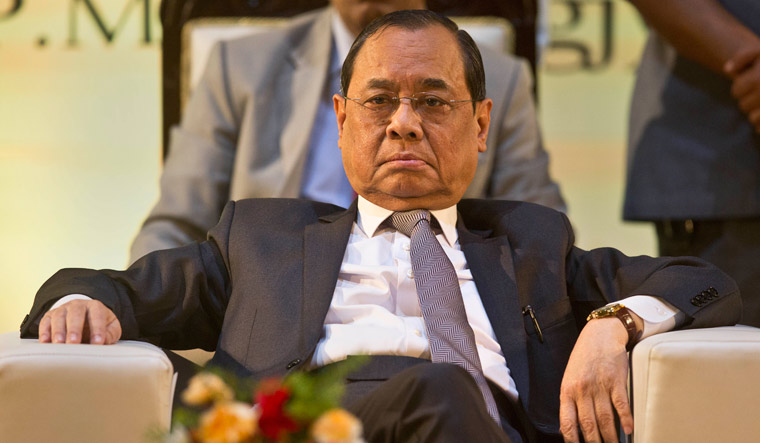When former chief justice of India Dipak Misra misbehaved in allocating cases in the Supreme Court, four of the senior-most justices of the apex court, including Ranjan Gogoi, protested. These justices did so by holding an open press conference in January 2018 and speaking against Misra.
But Gogoi (I refuse to call him justice) committed much greater misconducts, of various kinds, and practically prostrated before the BJP-run government and handed over almost the entire Supreme Court to the political executive, giving up its solemn duty of protecting the rights of the people. However, when Gogoi did all this, not a single voice of open dissent was heard from any of the Supreme Court justices.
When the disgraceful MISA judgment (ADM Jabalpur vs Shivakant Shukla) of 1976 was delivered, there was at least the brave dissenting voice of justice H.R. Khanna.
But when the shameful Ayodhya verdict was delivered by the Supreme Court in November 2019, it was unanimous.
Gogoi was a blot on the judiciary, but on the judicial side, all judges are equals, and the chief justice is not their superior. Why then did the other justices surrender their consciences to Gogoi, as is evident from these instances (among several others):
1. There were five Supreme Court justices on the Ayodhya bench. It was of course expected of Gogoi to have done as he was told by the Union government. But how could the other four justices have agreed to such an outrageous, scandalous and opprobrious verdict? (See The Ayodhya verdict is based on a strange feat of logic published online). Where were the inner voices and scruples of these four justices? Or had the justices handed them over to Gogoi?
2.While rejecting the bail plea of columnist Abhijit Iyer Mitra in October 2018, Gogoi made a flippant and cruel remark: “The safest place for you is jail.” Now it is well settled after the leading judgment of the celebrated justice Krishna Iyer in State of Rajasthan vs Balchand in 1977 that bail, not jail, is the normal rule to be followed by Indian courts, unless the accused is likely to abscond or tamper with the evidence or is accused of a heinous crime. Abhijit had only tweeted a satirical remark about the Konark temple, for which too he had soon apologised.
Surely this was a fit case for granting bail, yet the petition was rejected. Gogoi, of course, was capable of not observing legal principles, but what about the other two justices on the bench with him? Why did they not dissent from Gogoi, and tell him this case deserved bail in view of the settled law? Why did they kowtow to him?
I remember when I was a judge of Allahabad High Court, I once sat on a division bench with a senior judge, who started passing orders in cases that we had heard without consulting me. After he did this in two or three cases, I told him this was not acceptable to me. I was an equal member of the bench, and must be consulted before any order was passed, otherwise I would not sign the orders. Why could the justices sitting with Gogoi not have told him the same?
3. In the case of Justice Akil Kureshi, why did the four members of the Supreme Court Collegium go along with Gogoi and succumb before the BJP government, which did not want a Muslim chief justice in the larger Madhya Pradesh High Court, and instead sent him to the much smaller Tripura High Court? Gogoi was of course expected to toe the government’s line, but what about the other four justices in the Collegium? Where were their consciences?
4. The shoddy manner in which Justice Pradeep Nandrajog was treated is well known. He was recommended unanimously by the five-judge Supreme Court Collegium for elevation to the Supreme Court, and all five justices had signed the recommendation (as retired justice Madan Lokur, then a member of the Collegium, told me). But Gogoi, at the instance of Justice Valmiki Mehta, who was inimical to Justice Nandrajog, kept the recommendation in his pocket till justice Lokur retired, and then got the recommendation recalled by a more pliable Collegium.
5. The shoddy manner in which former CBI director Alok Verma was treated by the Supreme Court bench headed by Gogoi is well known. However, Gogoi was not the only judge on the bench. What were the others doing when such a naked travesty of justice was being perpetrated?
6. In the case of the lady clerk who alleged she was sexually molested by Gogoi, the chief justice himself sat on a three-member bench constituted by him to hear the matter, along with two other justices of the Supreme Court. Gogoi did a drama of recusing himself from the hearing, but in that case the bench should have been broken up and the matter listed before another bench without Gogoi.
Why did the other 2 members on the bench acquiesce to this strange and egregious act of Gogoi continuing to sit on the bench after recusing?
Several other such shocking instances can be given. Gogoi is at fault during his tenure as chief justice of India, but why were the other justices in the Supreme Court mute like Bheeshma Pitamah, seeing the cheer haran of the Supreme Court? Are they not equally culpable? Why did they not hold an open press conference to recount Gogoi’s misdeeds, as was done in the case of Misra?
These are grave questions to which the people of India need answers, else their faith in the judiciary, which is already greatly weakened, will totally disappear.
Justice Markandey Katju retired from the Supreme Court in 2011
The opinions expressed in this article are those of the author's and do not purport to reflect the opinions or views of THE WEEK


